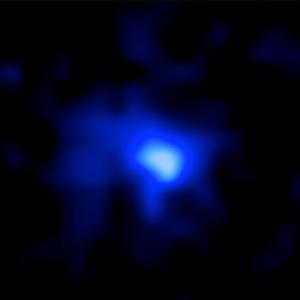Blog
Across the Universe
15 May 2015
Astronomers have discovered what seems to be the most distant galaxy yet discovered.1 The galaxy known as EGS-zs8-1 has a redshift of z = 7.73, trumping the previous record for a galaxy at z = 7.51. Several articles are giving a distance of this galaxy as about 13 billion light years away, but that’s not really an accurate measure, and it’s part of the reason we usually talk about redshift rather than distance.
 NASA, ESA, P. Oesch and I. Momcheva, and the 3D-HST and HUDF09/XDF Teams
NASA, ESA, P. Oesch and I. Momcheva, and the 3D-HST and HUDF09/XDF TeamsThe redshift of a galaxy is typically given by a number known as z, which is the difference between the observed wavelength of a particular emission line and the standard wavelength as measured here on Earth, divided by the standard wavelength. In this way, an object with no redshift would have a z = 0, and the greater the redshift the greater the z. The nice thing about redshift is that it’s purely an observational result.
From this z number we can infer a distance based upon Hubble’s law, which states that the greater the redshift the more distant the galaxy. But since Hubble’s law also means the universe is expanding, we have to be careful about which distance we mean. Do we want the distance of the galaxy when the light left it? The distance the light traveled to get to us? Or the distance of the galaxy now? These are all different.
With a z of about 7.73, that means the galaxy was about 3.4 billion light years away when the light left it. Because of the expansion of the space between us and the galaxy, it took the light about 13 billion years to reach us. But since then the galaxy has moved away from us at an ever greater rate, so it is now about 29.5 billion light years away from us.
That last distance might seem odd given that the universe is only 13.7 billion years old, but it’s important to keep in mind that the galaxy hasn’t traveled 26 billion light years in 13 billion years. In fact any actual motion away from us through space would be in addition to the 26 billion light years. That last distance is entirely due to the expansion of space between us. In an expanding universe, distance is always changing.
Which is why astronomers tend to stick with redshift.
Oesch, P. A., et al. “A spectroscopic redshift measurement for a luminous Lyman break galaxy at z= 7.730 using Keck/MOSFIRE.” The Astrophysical Journal Letters 804.2 (2015): L30. ↩︎